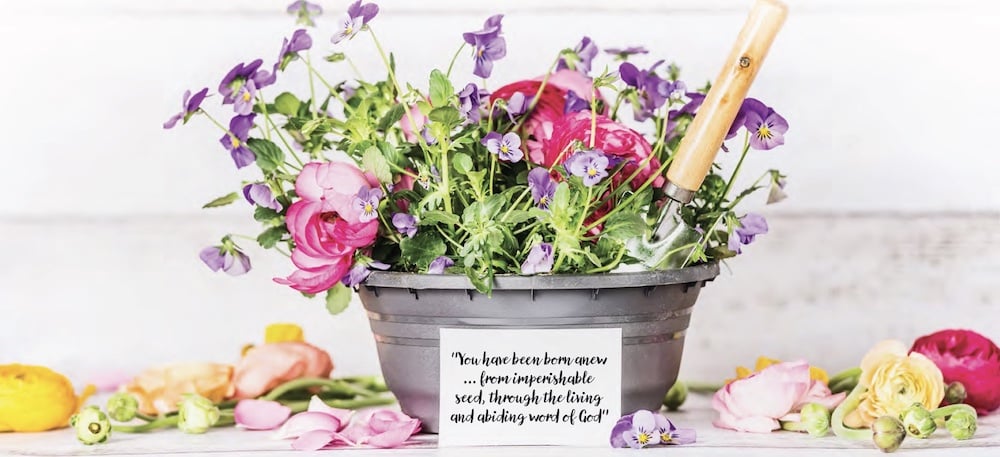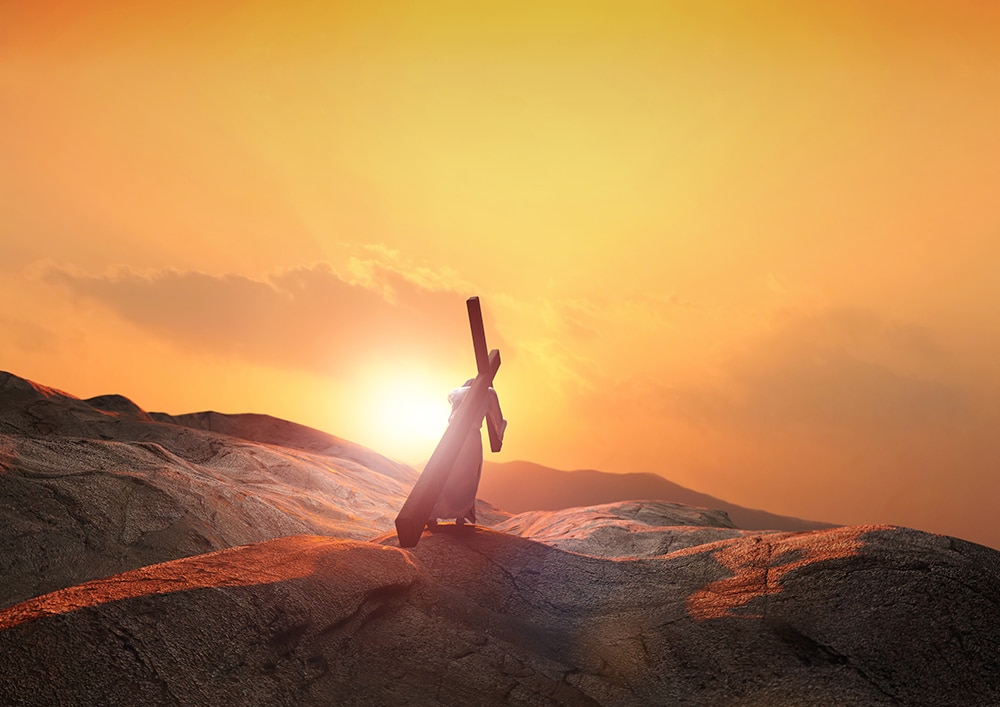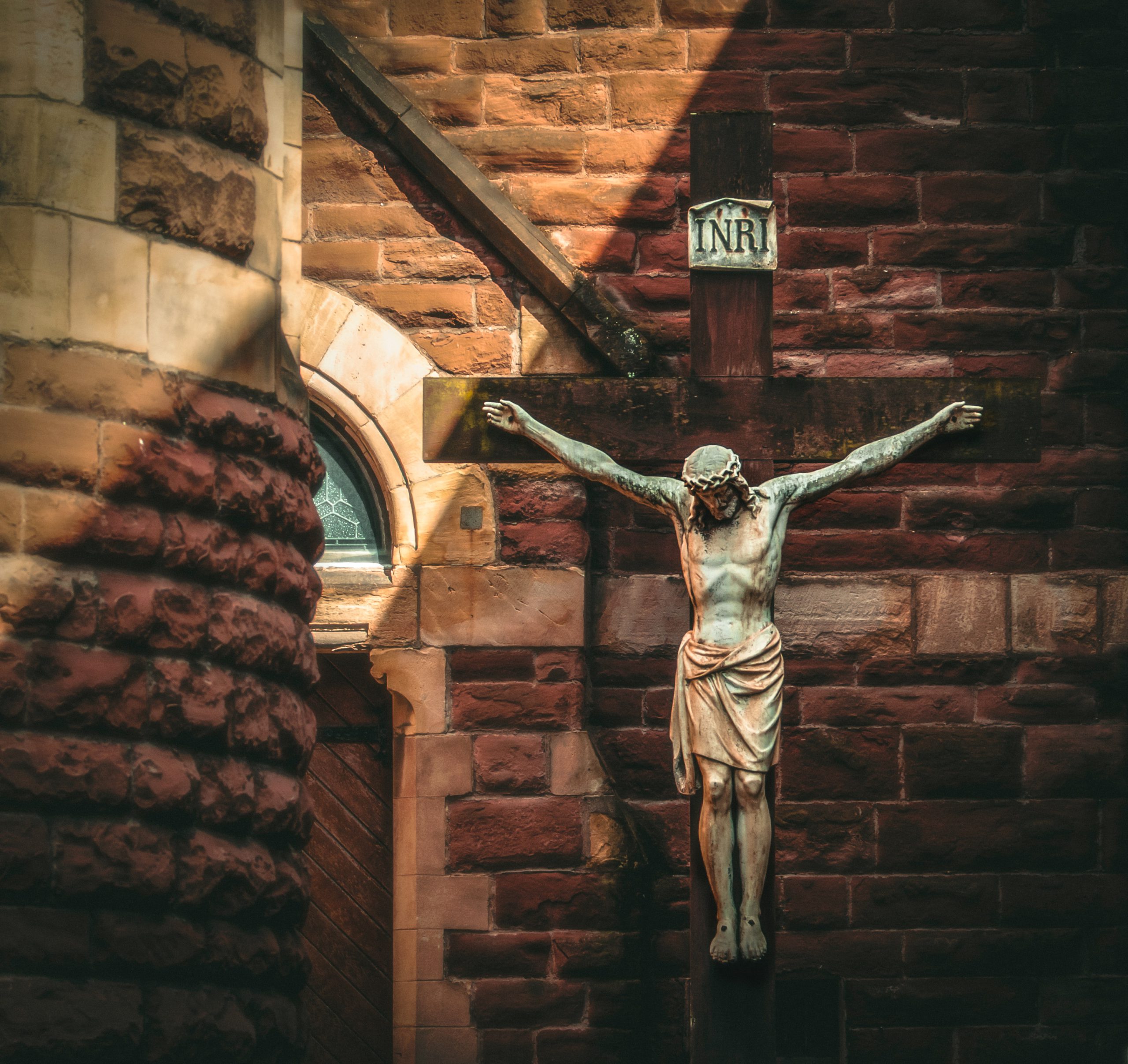We draw closer to God with the recognition that in all things he is glorified, not only through human endeavors but also in our gardens, running our farms, or having wilderness adventures. God’s economy of salvation can be appreciated at any time but perhaps mostly in the spring, when new life reminds us of the promise that we can always begin again.
The darkest days of winter are behind us as we move toward the increasing light of spring — lecten in Old English, the lengthening of days. More light permits new growth. What a wonderful analogy for growing anew during Lent, and the unfurling of faith in the light of Easter.
In all of this, we hope our Lenten disciplines help us to turn to God the way plantings turn to light. Just as there are tasks that must be done in order to maintain a healthy and productive garden, so, too, do we live out the metaphor as we attend to the interior garden of our soul. And in our gardens, we can find analogies for cultivating a new virtue or reinforce existing ones grown pale or weak.
So, it’s time for a spiritual spring cleaning — time to look at the mess of our dormant interior gardens and see what the winter of the world has left behind. Let’s clean up and declutter to make room for our beautiful new growth.
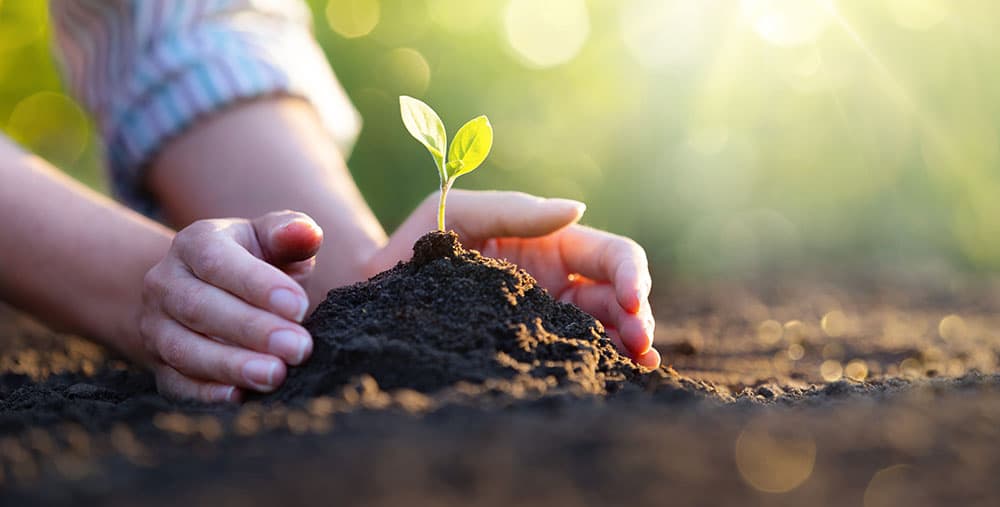
1. Prep the foundation
Our work in the garden of our soul is, as Wendell Berry has shared, to be directed by affection — for the love of task, for the love of the thing. Let the Holy Spirit’s guidance direct you toward virtues and devotions most needed in your interior garden, and ask your guardian angel for protection from distractions.
Gardeners know there is a sequence to beginning to clear away for spring growth. We don’t spread compost before the weeds are cleared away. Similarly, our spiritual cleaning shouldn’t add a practice or devotion until we understand what is yet lacking in our faith development.
Firstly, we mustn’t do too much too soon. Successful gardening (of the earth or the spirit) depends on easing gently into strengthening oneself — overworking at the start only exhausts us and delays the progress in the future. Devotions that are too demanding can weigh down our journey.
The ashes we received on Ash Wednesday remind us of who we are in all humility — we are dirt, the soil of creation. We are humilis, grounded, from the earth. The foundation of a garden is the good earth that supports it, and the soil of our soul is found in the foundation of humility. We must acknowledge that we can do nothing good without God.
The foundation of a garden is the good earth that supports it, and the soil of our soul is found in the foundation of humility. We must acknowledge that we can do nothing good without God.
Gardening is contemplative, silent work; as you work in your garden — whether a balcony of pots or an acre of land — you listen to God, become silent in his presence. Just so with your spiritual work.
Before you start your chores, place a crucifix, statue or icon in the garden (or your prayer space) where it can be easily seen. As you clear away the debris, look often to the holy object and ask for insight in cultivating your soul. Consider making a conscious decision to offer up your difficult work as an intercession for someone in deep need.
We begin gardening by clearing away the debris left behind by winter. During the winter months plants die back, and the harshness of the season breaks away weak or diseased branches. Buffeting winds, heavy snow loads or freezing rain test the strength of trees and shrubs through the storms. Those branches farthest away from the main trunk are most vulnerable to damage. How true is this for our own nature? The closer we stay to the source of spiritual growth, the stronger we remain.
As we notice the fallen limbs along a woodland trail or pick up scattered branches in the yard, we can discover how they broke away. There may be lichen on the bark indicating it was too old, maybe its central stem is blackened from disease, or what looked to be a healthy branch was shattered and split too weak to withstand a storm.
There is a goodness in the breaking away. It opens up the tree to better air movement and allows light to penetrate deeper into its recesses. And isn’t that a good thing for us as well? Let those old and diseased parts of us fall away! We are painfully blessed when the branches we’ve grown that were not as close to God as we had thought are gone, letting in more light.
| Dig deeper |
|---|
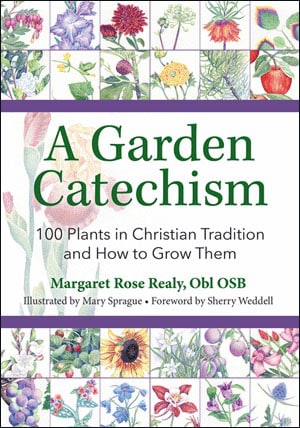 “A Garden Catechism: 100 Plants in Christian Tradition and How to Grow Them” (OSV, $34.95) “A Garden Catechism: 100 Plants in Christian Tradition and How to Grow Them” (OSV, $34.95)By Margaret Rose Realy, Illustrated by Mary Sprague Presenting accurate plant culture that is easy to understand, aesthetically pleasing, and grounded in Catholic history and tradition, “A Garden Catechism” is perfect for beginning and experienced gardeners alike. This unique, comprehensive resource combines the heritage of our Faith and the joy of gardening in a way that is accessible to anyone. Purchase at OSVCatholicBookstore.com. |
2. Weed and prune our souls
Now, let’s get to the dead leaves and old stalks. Cutting them away will allow for new growth to emerge uninhibited. Bear in mind, though, that what we think is waste is material that can be spread around the base of the plant to serve as mulch or added to a compost pile to be converted to nutritious soil as it decays. Experience does not have to be pretty to be worthwhile. Nothing goes to waste in a well-loved garden; even what we think is useless can be converted to good.
With all the debris cleared away, we see the ground and can start to remove the weeds — and weeds always come. Weeds, like little sins and bad habits, are specific to a particular environment and will flourish in that site. Removing them before they get a foothold (and spew about their miserable seeds) is easier than ignoring their presence until a full invasion has occurred.
Weed seedlings may look similar to desired seedlings. And isn’t that true for so many of our little sins? It’s an odd thing that most sins occur because of some anticipated good of it, and we can barely tell it from the actual good we seek.
While weeding, think of all your little sins, the repetitive ones, and imagine pulling those sprouting sins out of your soul as you pull the weeds from your garden. Don’t be discouraged when weeds return — and they will! — because they remind us to be attentive to the environment in which our goodness grows. Satan would prefer you didn’t notice the weeds.
With no leaves to block our view, it is then possible to see which branches are growing in the wrong direction, crossing over one another and rubbing each other raw, or which ones are bent from storms or broken in a way that invites disease and pests.
While weeding, think of all your little sins, the repetitive ones, and imagine pulling those sprouting sins out of your soul as you pull the weeds from your garden. Don’t be discouraged when weeds return.
Not all pruning practices work well for every species. The technique for pruning crabapple trees is far different from what is done for a Rose of Sharon. This is much the same as for how the Lord prunes us; he knows well the season to begin and which branches to remove. Pruning is not easy but is necessary, for the cut you make above a new bud will eventually bring the desired directional growth.
Place your initial pruning focus on the least desirable plant, the one you’ve ignored or neglected for some time. It, like people often pushed aside, will tend to flourish when given attention and properly attended to.
As we work cleaning up our gardens in the spring, and throughout the growing season, we gather up the debris. The material we thought of as waste to be discarded is actually purposeful and recycled through composting. Composting allows for plant material to break down and creates a nutritious mix to be returned to the earth. Nothing is wasted and even our trials and misfortunes, our debris, can be broken down and become the fodder for growth.
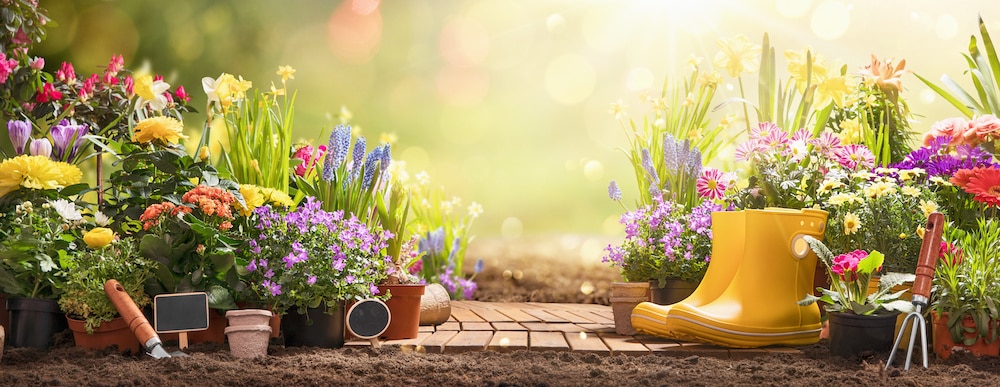
3. Encourage new growth
Now that we’ve attended to cleaning things up, let us continue to encourage new growth. The garden space has been cleared of obstructions and we can spread last year’s compost, the black gold of the garden. Having “composted” our own spiritual debris, we can see the “gold” of fresh insights.
We have soil that is now fertile ground, and we are prepared to add new plants or seeds. We know that not all seeds need the same environment to grow. There are seeds that need light to germinate, and others that develop in darkness. The miracle of seeds is that everything needed for growth God has already placed within it. It has its entire DNA, is already fertile, and is hanging in the balance waiting for its upcoming life. It is like there is a fleck of light in the center of the seed waiting to get out, seeking the light beyond itself. So true also for the seeds God has planted in our souls.
In Scripture we read, “You have been born anew … from imperishable seed, through the living and abiding word of God” (1 Pt 1:23). This economy of salvation, and its continued growth, is accomplished through us, the Body of the Church, expressed within a sacramental life (cf. Catechism of the Catholic Church, No. 876). The indestructible seed of the holy is within us waiting to be expressed.
Trying new seeds is important. … Is there a new seed of faith to germinate that can grow beyond Easter? A new saint whose life can edify your own?
Every seed is purposeful, even if a weed, though its function in our life may differ. It matters that we plant seeds that will nourish us, but we also need to plant seeds that bring us joy. God had not intended for his creatures to be only dutiful and somber. He gave us all the emotions to express all our experiences, so his flowers matter as much to bring us delight as his grains to provide our food, and the weeds to keep us aware of what will inhibit good growth.
We may have favorite seeds, those which grow best in our environment and produce the best blooms, offering the most abundant crop. But trying new seeds is important. At one time your now favorite seeds were new and you waited with eagerness to learn what would unfold.
Do you have spiritual practices that, too, are familiar and reliably productive? Is there something a bit different from your old reliable ways that you could try? Is there a new seed of faith to germinate that can grow beyond Easter? A new saint whose life can edify your own?
We watch established perennial plants resurrect from frozen ground, watch seedlings unfurl and reach for sunlight, and often smell the fruit tree’s bloom assured of an autumn harvest. And a good gardener knows the importance of protecting these plants throughout the season.
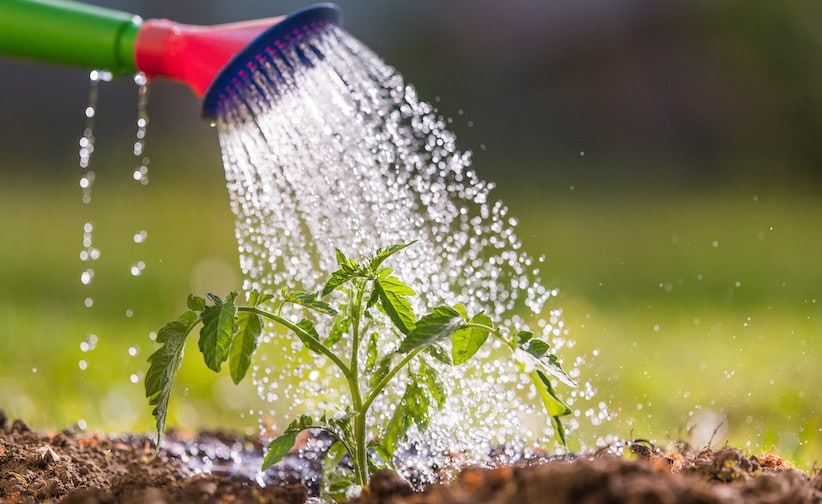
4. Feed your garden
We are now to the point where everything has been cleaned up, the soil enhanced with compost, and plants are beginning to develop. Here a layer of protective mulch is advised. This covering will minimize weeds and retain moisture often lost during the scorching heat of summer.
This blanketing is much like our guardian angel’s wings, a defense against the accumulation of sin, holding close those things needed for good roots, allowing us to be able to withstand any amount of heat from society.
As you spread the mulch, think of a Bible passage that reassures you of God’s blanketing love and mercy, and for his gifts that allow for your stable growth.
It is necessary for healthy growth that plants be properly fertilized — fed. Too much of one thing can cause deficiencies in another. Too much nitrogen and a plant may not flower, too much phosphorus and the plant may be stunted, not enough potassium and the roots suffer and the plant cannot thrive.
A balance in our prayer life is important, too. All of our prayers are good; some are needed in regular amounts to keep up with our development. But there are those little shorter prayers offered throughout our day, those small bits of gratitude or petitioning “come Holy Spirit” that are like the micronutrients needed by plants for overall well-being.
It is necessary for healthy growth that plants be properly fertilized — fed. Too much of one thing can cause deficiencies in another. … A balance in our prayer life is important, too.
All this food cannot be taken up, all this growth cannot take place without water. None of creation survives without water, and so very true for our soul. The holy water of baptism gives life to our dormant seeds of faith and our growing toward God.
As gardeners we know that a frequent light watering causes roots to develop near the surface. These roots are shallow and rarely able to withstand the demands of drought, and will not stabilize the plant through buffeting winds. A heavy soaking helps the roots to grow deeper and better secure the plant against the storms. Let us do more than absentmindedly tap a little holy water on our brows. Let us soak up the depths of our Church.
Much of what is needed for a healthy garden, and a healthy spiritual life, is attentiveness and incremental steps to maintain health. St. Teresa of Avila, who expanded on the concept of the garden of the soul, had written that God has done the work of planting good seeds and it is up to us to diligently tend and water these plants growing in the garden of our souls. She offers many practices for creating an interior garden in which Our Lord can take his delight, and simplistically put, she suggests we tend the garden of the soul faithfully, guard it from assault, and water it regularly with prayer.
We move through Easter and as the growing season continues, we can with gentle practice flourish to the time of harvest.
Margaret Rose Realy is a Benedictine oblate, master gardener, freelance writer and retreat leader. She writes from Michigan.
| Creating a prayer garden |
|---|
| Many of us enjoy being outdoors among nature, and find an ease in offering prayers when among creation. Your garden can be a mini retreat when you create a space within it to sit and pray and read.
Here are several questions for planning your prayer garden that will help you focus on creating your outdoor space. Although these questions may seem simplistic and obvious, answer them nonetheless.
Look at your answers. Do you see a pattern of intent or purpose? Synonymous words should be present in your answers; circle them, rewrite them, pray over them. These intentions are your foundation. From these you will look for objects or plants with symbolic meanings that match with and will enhance your prayer space. Keep in mind how color affects emotions. For more information, the book “A Garden Catechism,” published by OSV, can help guide you in creating an outdoor space for prayer. |

